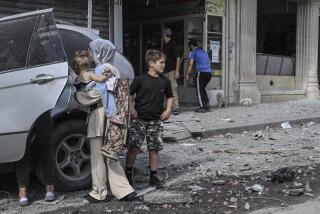Iran’s nuclear resolve fueled by Iraq’s chemical assault in war
- Share via
TEHRAN — Shahriyar Khatri was among many here welcoming news that this year’s Nobel Peace Prize was awarded to the Organization for the Prohibition of Chemical Weapons, the international agency that oversees a global ban on toxic armaments.
“I’m very glad that people finally know more about the OPCW and its important work,” said Khatri, a toxicologist and physician who works with a government-backed group raising awareness about the plight of chemical attack victims of Iran’s 1980-88 war with neighboring Iraq.
As a teenage militiaman, Khatri was gassed during that conflict, which included extensive chemical attacks by the forces of late Iraqi President Saddam Hussein.
This week, global attention is focused on talks in Geneva about Iran’s disputed nuclear program. Tehran says its nuclear effort is for purely peaceful purposes, despite U.S. suspicion that the Iranians are clandestinely seeking to build atomic weapons.
But amid revived hope of a U.S.-Iran rapprochement after decades of hostility, the issue of chemical weapons still resonates deeply in Iran. The traumatic 1980s war remains both a bitter memory and a touchstone of resolve for the Islamic Republic.
The fact that the U.S. government did nothing to stop or condemn Iraq’s use of chemical weapons during the 1980s conflict — and even provided targeting information to Iraq’s forces, according to recent revelations in Foreign Policy magazine — has contributed to doubts here about U.S. intentions in the nuclear talks and other issues.
The Iran-Iraq conflict may be a distant event for U.S. policymakers, but it remains a source of profound resentment and a cautionary tale in Iran.
The poison gas strikes that occurred outside Damascus, the Syrian capital, on Aug. 21 generated widespread revulsion in Iran. The incident also revived international interest in the chemical assaults a generation earlier.
The Iran-Iraq war, which killed as many as 1 million combatants and civilians and injured an equal number, is often recalled for its revival of World War I-style trench combat. But the conflict also shared another murderous attribute of the Great War: the deployment of chemical weapons. Hussein’s military rained down vast quantities of toxic gases on Iranian and Kurdish forces and civilians.
The “horrific” Iraqi attacks, Khatri said in an interview, “opened the eyes of the world” to the chemical threat.
The 1980s carnage provided impetus for passage of the Chemical Weapons Convention, a 1997 arms control treaty banning the use, production and stockpiling of such weapons. Overseeing compliance is the Hague-based OPCW, which last week was awarded the Nobel Peace Prize.
Iran is among 190 signatories to the convention. On Monday, Syria formally joined after agreeing to a U.S.-Russian plan to eliminate its extensive chemical stockpiles, an accord widely praised in Iran. The OPCW and the United Nations are supervising the effort to destroy Syria’s arsenal by mid-2014 amid a raging civil war.
According to official estimates, about 65,000 Iranian civilians and war veterans still suffer from the effects of Iraq’s chemical bombardment. News reports here regularly include brief mentions of veterans dying of chemical-weapons-related ailments.
Still, Iranian officials have stuck by their close ally, Syrian President Bashar Assad, whom U.S. officials and others blame for the chemical strikes in Damascus suburbs. Assad and his allies have blamed antigovernment rebels for the attacks, which killed hundreds of people. Neither side has provided definitive proof of who was behind the chemical barrage, described as the worst since the 1980s war.
That protracted conflict, which ended in a U.N.-brokered cease-fire and a restoration of prewar international borders, is recalled in the Tehran Peace Museum, situated in the northern reaches of the Park-e-Shahr, one of the oldest green spaces in the crowded capital.
In a museum office, where the bookshelves feature copious chemical weapons texts and a copy of Leo Tolstoy’s classic “War and Peace,” Khatri greets a visitor and recites the grim casualty figures of Iraq’s mustard gas and sarin onslaught. The latter is the same nerve agent recently unleashed outside Damascus.
“More than 8,000 people [in Iran] were killed directly during Saddam’s chemical bombardments,” said Khatri, and tens of thousands of other Iranians and Iraqi Kurds were exposed to chemical agents.
In the Iranian capital, he noted, several hospitals specialize in treatments for more than 65,000 veterans and civilians still suffering from the effects of the attacks, including respiratory ailments and loss of vision. Cancer rates are also elevated among chemical attack survivors, he said.
Khatri, 43, a father of three, said he joined the battle on the Iraqi front as a teenage volunteer with the Basiji militia and still suffers periodic asthma attacks from his exposure to toxic gas.
From his base here, Khatri and his colleagues train physicians in the treatment of chemical attack victims. International sanctions tied to Iran’s nuclear program have complicated their task, he said, causing a shortage of some imported drugs, including immune suppression medicines vital for those in need of cornea transplants.
“Once we were told that chemical bombs are an old and obscene weapon, to forget about them,” Khatri said. “But with Syria we have seen that the evil genie of chemical weapons is once again out of the bottle.”
Special correspondent Mostaghim reported from Tehran and Times staff writer McDonnell from Beirut.
mes staff writer McDonnell from Beirut.
More to Read
Sign up for Essential California
The most important California stories and recommendations in your inbox every morning.
You may occasionally receive promotional content from the Los Angeles Times.










